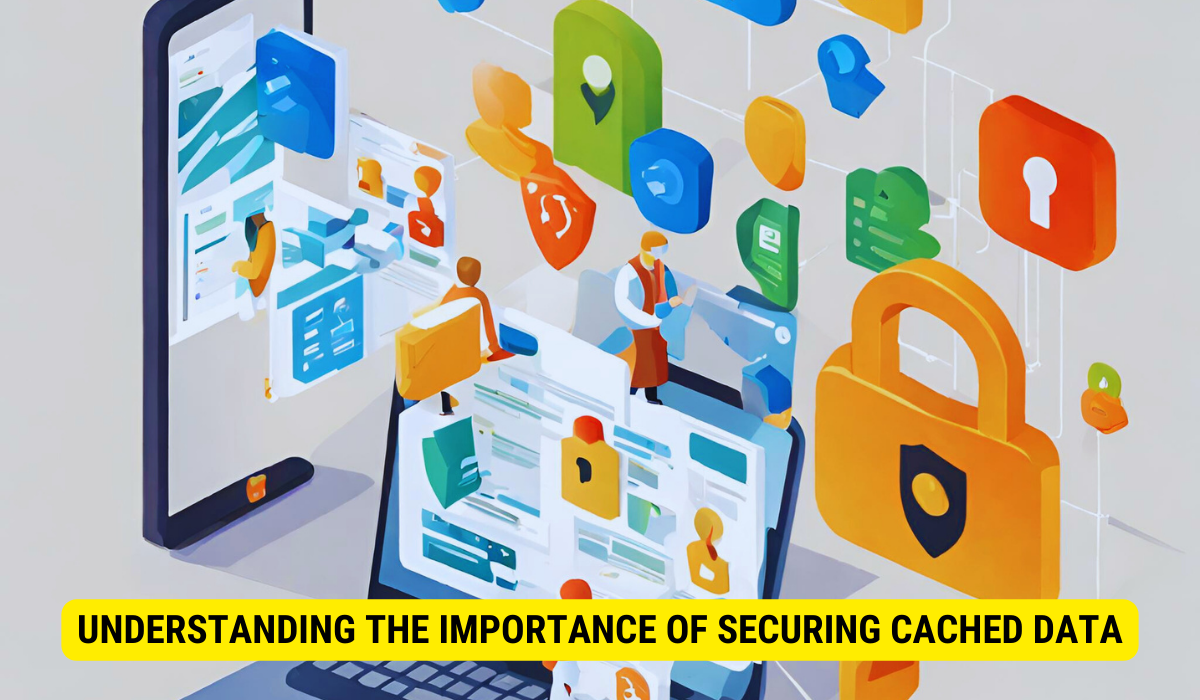To secure cached data, implement strong encryption algorithms, establish proper access controls, prevent cache poisoning, conduct regular audits and monitoring, and keep systems updated with the latest security patches. Employee training and awareness are also pivotal to enhancing the overall security of cached data.
In today’s digital age, where data is constantly being accessed and processed, the security of cached data has become a matter of utmost importance. Understanding the risks associated with unsecured data and implementing proper techniques is essential when securing cached data. I will delve into the many aspects of securing cached data and provide you with best practices to ensure the safety of your valuable information.
Understanding the Importance of Securing Cached Data

Before we dive into the techniques for securing cached data, it’s crucial to understand the significance of this issue. Cached data temporarily stores frequently accessed data, allowing faster retrieval and improved performance. However, if this cached data is left unsecured, it can pose serious risks to your organization’s sensitive information.
When securing cached data, it’s important to consider the risks of leaving it unsecured. One of the key risks is the potential exposure of sensitive information to unauthorized users. As cached data is stored on servers and devices, unauthorized access can lead to valuable data falling into the wrong hands. This can result in data breaches, identity theft, financial loss, and damage to your organization’s reputation.
In addition to the risk of exposure, unsecured cached data can also be vulnerable to attacks such as cross-site scripting (XSS) and injection attacks. Hackers can exploit these vulnerabilities to inject malicious code into the cached data and, upon retrieval, execute malicious actions on the user’s device or compromise other systems. This highlights the importance of executing robust security measures to protect against such attacks.
Risks Associated with Unsecured Cached Data
One key risk related to unsecured cached data is the potential exposure of sensitive information to unauthorized users. As cached data is stored on servers and devices, unauthorized access can lead to valuable data falling into the wrong hands. This can result in data breaches, identity theft, financial loss, and damage to your organization’s reputation.
In addition, unsecured cached data can also be susceptible to attacks such as cross-site scripting (XSS) and injection attacks. Hackers can exploit these vulnerabilities to inject malicious code into the cached data and, upon retrieval, execute malicious actions on the user’s device or compromise other systems.
Furthermore, unsecured cached data can also lead to compliance violations. Many industries have strict regulations and guidelines in place to protect sensitive information. Failure to secure cached data can result in non-compliance, leading to legal consequences and fines.
Another risk associated with unsecured cached data is the potential for data corruption or loss. Cached data can be easily modified or deleted without proper security measures, leading to inconsistencies and potential system failures.
Benefits of Securing Cached Data
Organizations can enjoy many benefits by taking appropriate measures to secure cached data. Firstly, securing cached data ensures the privacy and confidentiality of sensitive information. This is particularly crucial when dealing with personally identifiable information (PII) or financial data, where any compromise can have severe legal and financial consequences.
Additionally, secured cached data enhances the overall integrity of your system. This means the data stored in the cache remains consistent and accurate, reducing the chance of unauthorized modifications or data corruption. Moreover, securing cached data can minimize the impact of potential attacks by limiting access to critical information and preventing unauthorized changes.
Furthermore, securing cached data can also improve the performance and efficiency of your system. By executing security measures, you can ensure that only authorized users can access the cached data, reducing the risk of unauthorized entry and improving overall system performance.
Lastly, securing cached data can help organizations maintain compliance with industry regulations and standards. By implementing security measures that align with these regulations, organizations can avoid legal consequences and maintain the trust of their customers and partners.
Basics of Cached Data
Now that we understand the importance of securing cached data let’s explore the basics of how cached data works.
Cached data is a fundamental concept in modern computing that plays a crucial role in improving the performance and efficiency of applications. It refers to a copy of previously accessed data stored closer to the user or application for faster retrieval. This copy of data can be stored on local devices, servers, or at the network edge. Having cached data helps reduce the latency and bandwidth usage when accessing frequently requested information.
What is Cached Data?
Simply put, cached data is a mechanism that allows systems to store regularly accessed data in a place that is easily accessible. It is a temporary storage space that holds copies of previously retrieved data. Storing this data closer to the user or application eliminates the need to fetch it from the original source whenever requested.
Imagine a scenario where you are browsing a popular news website. Every time you visit the website, it must fetch the latest news articles from its database. However, if the website implemented a caching mechanism, it would store a copy of the most recent articles in its cache. So, when you visit the website again, instead of retrieving the articles from the database, it will fetch them from the cache, resulting in faster loading times and reduced server load.
How Does Cached Data Work?
Cached data works based on the principle of locality. It leverages the fact that users tend to access the same information repeatedly. When a user requests data, the system checks the cache first. If the data is found in the cache, it is fetched from there, avoiding the need to retrieve it from the source. This process is known as a cache hit.
However, if the data is not present in the cache or has expired, it must be retrieved from the source and stored in the cache for future use. This is known as a cache miss. When a cache miss occurs, the system fetches the data from the source, such as a database or an external API, and stores it in the cache. Subsequent requests for the same data can then be served from the cache, resulting in quicker response times.
Cache expiration is an important aspect of cached data. To ensure that the cached data remains up to date, it is assigned an expiration time or is invalidated when the original data is modified. When the expiration time is reached or the data is invalidated, the next request for that data will result in a cache miss, and the system will retrieve the updated data from the source.
Different caching strategies can be employed depending on the specific requirements of an application. Some common strategies include time-based expiration, where the data is cached for a specific duration, and cache invalidation, where the data is invalidated when it is modified. Additionally, caching can be implemented at various levels, such as the browser, server, or even at the network edge using content delivery networks (CDNs).
In conclusion, cached data is a powerful concept that improves the performance and efficiency of applications by storing regularly accessed data closer to the user or application. By leveraging the principle of locality and employing various caching strategies, systems can reduce latency, minimize bandwidth usage, and improve overall user experience.
Common Vulnerabilities in Cached Data
While cached data provides performance benefits, it also introduces certain vulnerabilities that must be addressed to ensure robust security.
Inadequate Encryption
One common vulnerability in cached data security is inadequate encryption. If the cached data is not properly encrypted, it becomes susceptible to unauthorized access. Encryption is vital in protecting sensitive information from being exposed or tampered with while it is stored in the cache and during transmission.
Poor Access Controls
In addition to encryption, proper access controls are crucial to prevent unauthorized users from accessing cached data. Poorly implemented or weak access controls can make it easier for attackers to gain unauthorized entry or escalate their privileges, leading to potential data breaches.
Cache Poisoning
Cache poisoning is another vulnerability that can compromise the security of cached data. In cache poisoning attacks, hackers manipulate the cache’s content, delivering malicious or tampered data to unsuspecting users. This can have severe implications, such as spreading malware or compromising the system’s integrity.
Techniques for Securing Cached Data
Now that we know the vulnerabilities associated with cached data let’s explore some essential techniques for securing it.
Implementing Encryption
One of the fundamental techniques for securing cached data is implementing strong encryption algorithms. Encrypting the cached data ensures that it remains unreadable and unusable even if it falls into the wrong hands. Robust encryption protocols and encryption keys should be prioritized to provide an extra layer of security.
Setting Up Proper Access Controls
To protect cached data, proper access controls are essential. This involves implementing a robust authentication mechanism to ensure that only authorized operators can access the data. Additionally, it is crucial to have role-based access controls (RBAC) in place, limiting access privileges based on the user’s role and responsibilities.
Preventing Cache Poisoning
Preventing cache poisoning attacks is paramount to maintaining cached data’s integrity and security. Techniques such as data validation, input sanitization, and secure coding practices should be employed to ensure that the content stored in the cache remains invulnerable to manipulation or tampering attempts.
Best Practices for Cached Data Security

Securing cached data is an ongoing process that requires consistent effort and vigilance. Here are some best practices to keep in mind:
Regular Audits and Monitoring
Regularly auditing the security of your cached data and monitoring its access and usage is crucial to classify any potential vulnerabilities or suspicious activities. This helps detect and address security threats promptly, minimizing the risk of data breaches or illegal access.
Updating and Patching
Keeping your systems, servers, and caches up to date with the up-to-date security patches and updates is essential to protect against known vulnerabilities. Regularly reviewing and applying patches ensures that any weaknesses or loopholes in the security infrastructure are addressed promptly.
Employee Training and Awareness

Lastly, educating your employees about cached data security and best practices is critical. Training programs and awareness campaigns can help employees recognize potential security threats, adhere to security protocols, and promptly report suspicious activities.
Key Takeaways
- Importance of Encryption: Properly encrypting cached data is foundational, ensuring unauthorized users can’t easily interpret or tamper with the information.
- Access Controls: Implementing robust access controls, such as strong authentication mechanisms and role-based access, limits only data access to authorized personnel.
- Preventing Cache Poisoning: Techniques like data validation, input sanitization, and secure coding practices can safeguard cached content from tampering.
- Regular Monitoring: Periodic audits and consistent monitoring of cached data access help detect suspicious activities or vulnerabilities early.
- Employee Awareness: Educating employees about the significance of cached data security and best practices can substantially mitigate human-induced security risks.
FAQs
What is cached data?
Cached data temporarily stores frequently accessed data, allowing quicker retrieval and improved system performance.
Why is securing cached data essential?
Securing cached data is crucial to protect sensitive information from unauthorized access, exposure, and potential cyberattacks, ensuring system integrity and data privacy.
What vulnerabilities are associated with cached data?
Some vulnerabilities include inadequate encryption, weak access controls, and cache poisoning.
How does encryption aid in securing cached data?
Encrypting cached data ensures it remains unreadable and inaccessible without the proper decryption key, adding a layer of security against unauthorized access.
What is cache poisoning?
Cache poisoning is an attack where hackers manipulate the cache’s content, delivering tampered data to users, potentially spreading malware or compromising system integrity.
Conclusion
Securing cached data is paramount in today’s digital environment. By comprehending the risks and implementing strategic techniques complemented by regular oversight, organizations can bolster their data protection efforts, ensuring that cached information remains confidential, integral, and consistently available.
